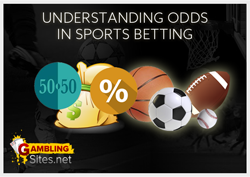Understanding Odds in Sports Betting
 Betting odds, especially for novice bettors and for those that are new to sports betting, can be difficult to grasp. There are several types of betting odds that are offered to players, but they all have one common theme – they reflect the probability of an outcome in a sporting event.
Betting odds, especially for novice bettors and for those that are new to sports betting, can be difficult to grasp. There are several types of betting odds that are offered to players, but they all have one common theme – they reflect the probability of an outcome in a sporting event.
In every sporting event, there can be a wide degree of difference from one outcome occurring compared to another. Betting odds are the interpretations of these chances in numerical form. Of course, since the bookmakers charge vigorish, the odds won’t reflect the true probability of an outcome but more on that later.
Depending on what part of the world you’re betting from, you’re likely to become accustomed to one form of betting odds or another. Online sportsbooks these days will offer their customers odds in several formats, but it’s important to understand each odds format.
American Odds
Also known as moneyline odds, American odds are used primarily by those based in the United States. American odds are simple to understand. The odds are based off the amount that must be bet for the bettor to win $100.
Sports like baseball are bet solely with moneyline odds because there is no point spread. However, traditional point-spread wagering will also have American odds attached. The standard bookmaker’s vigorish is -110, which will be the standard juice attached to sides and totals.
Here’s a basic example using an MLB baseball game:

Cincinnati Reds
-130

Chicago Cubs
+120
In terms of moneyline wagers, like all baseball contests, the favorite will be signified with a – negative symbol and the underdog with a + positive symbol. In the above example, the Reds are the favorite, and the Cubs are the underdog.
Bettors would need to wager a stake of $130 to win $100 if wagering on the Reds. For the Cubs, a $100 bet would return $120.

Bettors must wage
$130
In order to win
$100

Bettors must wage
$110
In order to win
$120
Here’s an example of American odds attached to an NFL point spread.

Cleveland Browns
(+3.5)
-110

Pittsburgh Steelers
(-3.5)
-110
The moneyline odds attached to each side of the point spread are -110. To bet either side, NFL bettors will need to bet $110 to win $100. For Americans, this 10 percent vigorish is standard. However, bookmakers often change the attached vig on point-spread markets. This is another way for them to move the line without coming off certain numbers.
Decimal Odds
Decimal odds are the most commonly used odds type by online bookmakers. They are the favorites of most Europeans, excluding the United Kingdom, and by Australians. Decimal odds follow a simple and basic formula.

Here is an example of a wager placed on the favorite in an English Premier League soccer match:


Fractional Odds
Fractional odds are predominantly used throughout the UK and Ireland. They are also known in the UK as UK Odds. First appearing in horse racing, they are the oldest form of odds in sports betting.
We all learned fractions as kids in school, and using fractional odds is no different. When using fractional odds, the second number to the right is the denominator, and it signifies the amount of the stake. The first number and number to the left is the amount that your stake will yield (not including the original stake) if the wager is a winner.
Here’s yet another example using English soccer:

Here is another example, this time with an odds-against underdog:

Odds Conversion
Many bettors will want to convert fractional odds to moneyline odds or decimal odds to American odds, etc. This can be done using some basic math, but in today’s bookmaking age, it’s not necessary.
Most sportsbooks offer several different odds types, so changing betting markets into different odds types can almost always be done with a click of a button. Bettors can also Google the term “odds converter,” and they will be met with several betting calculators that provide this service as well.
Do Betting Odds Represent the True Probability of an Outcome?
While betting odds are indeed the best barometer for predicting the outcome of a sporting event, the odds don’t necessarily reflect the true likelihood or probability of the outcomes concerned.
For instance, if we flip a coin, we know that there’s a 50% chance that it will land on heads and 50% chance it will land on tails. When a bet is placed, we will either win our side of the wager or lose (or push in some cases). This seems like a 50/50 proposition as well, but the bookmaker’s vigorish adds an edge to both sides of the bet.
Furthermore, the odds can be influenced by other factors. Not every bookmaker has the same opinion on a game, and the odds may also be affected by how much exposure a sportsbook has to each market. If they are taking a lot of action on one side, the odds will likely move due to the increase in wagering volume.
As a sports bettor, our goal should be to look for markets with the smallest edges held by the sportsbook. The closer we can get to the 50/50 coin flip odds, the less the sportsbooks will make off us in the long run. Of course, betting with no juice isn’t possible, but line shopping and cutting down on your edge is something that all bettors can do easily.

 MENU
MENU










